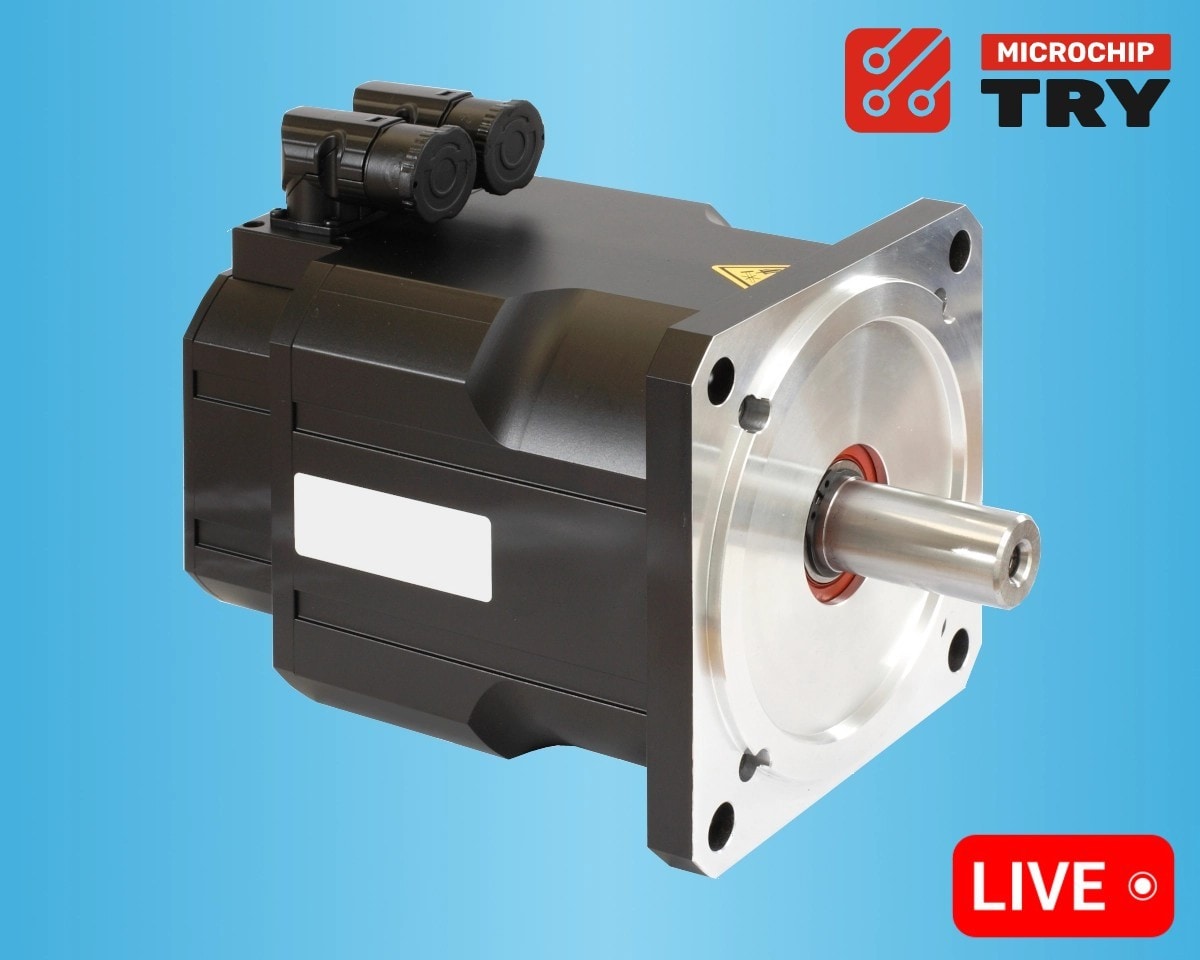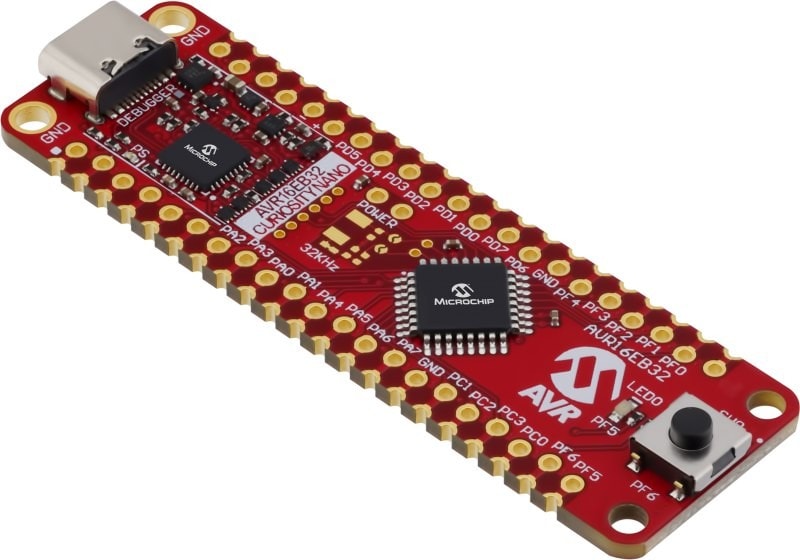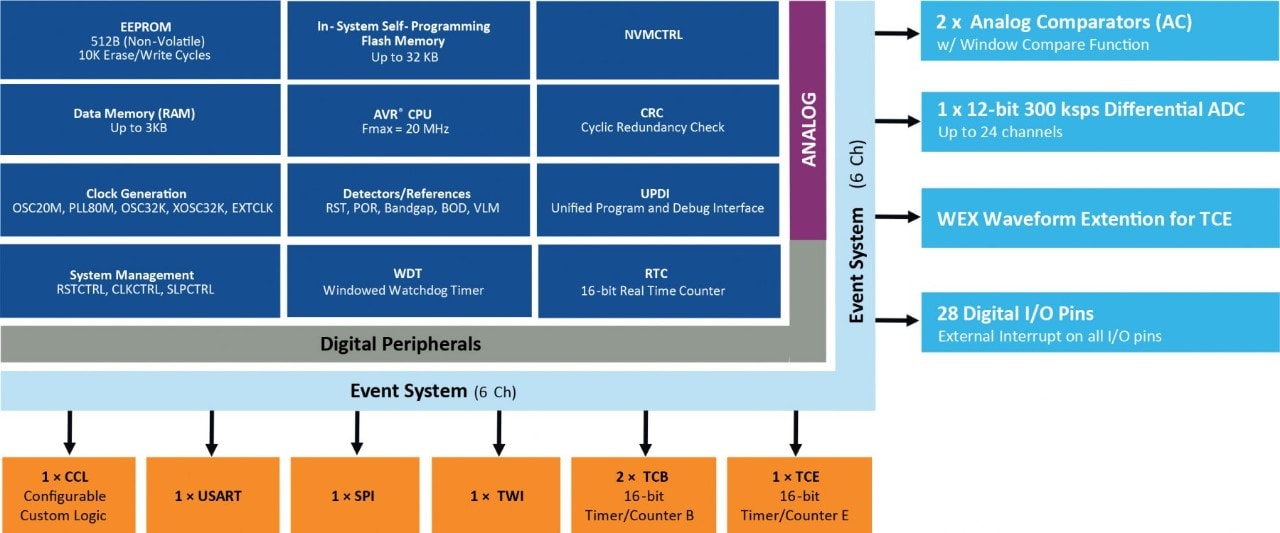AVR® EB MCUs for Motor Control and Analog Sensing
AVR EB MCUs are general-purpose MCUs with dedicated hardware for motor control, such as the timer/counter type E and waveform extension, which make motor control easier to implement. This MCU also has peripherals for analog sensing such as the Programmable Gain Amplifier (PGA), two analog comparators and a 12-bit Analog-to-Digital Converter (ADC). Other features include:
- Motor control library
- Advanced timers/counters
- Up to 80 MHz Phase-Locked Loop (PLL)
- Configurable Custom Logic (CCL)
- Event System
AVR EB MCUs for Motor Control
The AVR EB family is capable of driving the following types of motors:
- Brushed DC motors
- Brushless DC motors
- Permanent-magnet synchronous motors
- AC induction motors
- Stepper motors
With the help of the multi-phase power board and our motor control library, you can start testing the AVR EB MCU and its motor control capabilities in an instant. Try the multi-phase power board online on Microchip Try or access the motor control library today.

Enhanced Timers and Waveform Generation
The AVR EB family uses enhanced timer/counter modules to enable advanced waveform generation for power and motor drive applications. These MCUs have a Timer/Counter Type E (TCE) and a Timer/Counter Type F (TCF) at their disposal. The TCE is a 16-bit timer with four compare channels that allow it to trigger multiple events at different points and a high-resolution function that increases the resolution of the waveform generated up to eight times. The TCF is a 24-bit timer/counter that can generate frequency at a high resolution while also running asynchronously from the peripheral clock, allowing for high-speed operation.When used in conjunction with the Waveform Extension (WEX) these MCUs enable extra functions for Timer/Counters in Waveform Generation (WG) modes. It generates complementary waveforms, controls dead-time, pattern generation and fault handling.
Getting Started
The AVR16EB32 Curiosity Nano board is the best platform for rapid prototyping with the EB Family of MCUs. This USB-powered kit features an on-board programmer/debugger that seamlessly integrates with MPLAB® X, Microchip Studio and IAR Embedded Workbench for AVR® Integrated Development Environments (IDEs). Its small form factor makes it excellent for breadboard soldering, or you can combine it with the Curiosity Nano Base for Click boards™, which features multiple mikroBUS™ sockets so you can easily add sensors, actuators or communications interfaces from Mikroelektronika’s extensive selection of Click boards.
- MPLAB X IDE Projects
- Training Videos (Six episodes on getting started with the 12-bit differential ADC and PGA)

Functional Safety Support for Safety-Critical Applications
Our AVR EB family for safety-critical applications targets both industrial and automotive products. We also offer the MPLAB XC8 Functional Safety Compiler License, which is a TÜV SÜD-certified compiler package that supports 8-bit PIC® and AVR MCUs. Our ISO 26262 and IEC 61508 functional safety packages for the AVR EB family come with documents such as FMEDA reports and safety manuals.
System Features
Real-Time Response
Event System (EVSYS)
The EVSYS allows peripherals to communicate directly with each other without involving the CPU or bus resources. This means that different triggers at the peripheral level can result in an event, such as a timer’s interrupts triggering an action in another peripheral. The EVSYS has three independent channels for direct peripheral-to-peripheral signaling. This deterministic signaling method is a perfect fit for real-time applications. The events are handled at the peripheral level even if the CPU is occupied handling interrupts or in sleep mode.
Safety First
CRC, WWDT, BOR, POR, VLM
You can use the built-in features that support safety-critical applications to add robustness and reliability to your design. These include the Windowed Watchdog Timer (WWDT) for system supervision, the Cyclic Redundancy Check (CRC) for scanning Flash memory, and the Event System for fault detection. Other features include a Voltage Level Monitor (VLM), a Brown-Out Reset (BOR) and Power-On Reset (POR) for monitoring the supply voltage.
Hardware Customization
Configurable Custom Logic
The Configurable Custom Logic (CCL) peripheral is a programmable logic peripheral that can be connected to the device pins, events or other internal peripherals. Each Lookup Table (LUT) consists of three inputs: a truth table, an optional synchronizer and a filter and edge detector. An LUT can generate an output to be routed internally or to an I/O pin. This eliminates the need for external logic and reduces BOM cost.
Integrated Analog
12-bit Differential ADC With PGA, Analog Comparator
The on-board 12-bit, 300 ksps differential Analog-to-Digital Converter (ADC) features selectable internal voltage references with minimal temperature drift, and Programmable Gain Amplifier (PGA) supporting up to 16x gain making it possible to retrieve small signals in noisy environments. Using the Event System, the on-board Analog Comparators (ACs) can be connected to trigger autonomous operation in other peripherals, which is ideal for real-time control and closed-loop operations.
Power-Conserving Functionality
Idle, Standby, Power-Down
Idle and Standby low-power modes allow you to optimize your application for device performance and power consumption. The Power-Down allows unused peripherals to be turned off individually, further reducing power consumption.
